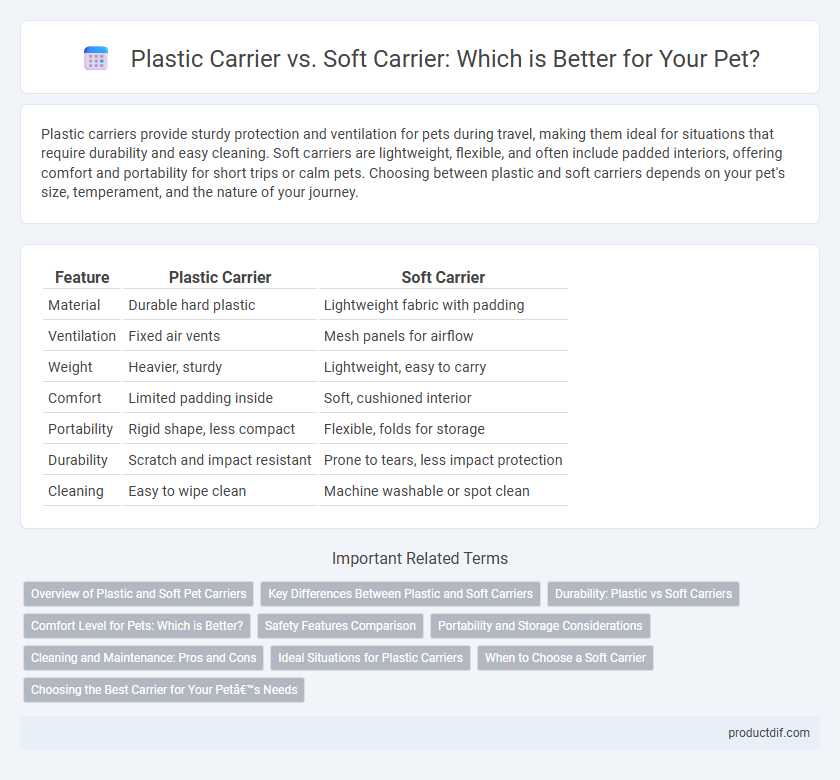Plastic carriers provide sturdy protection and ventilation for pets during travel, making them ideal for situations that require durability and easy cleaning. Soft carriers are lightweight, flexible, and often include padded interiors, offering comfort and portability for short trips or calm pets. Choosing between plastic and soft carriers depends on your pet's size, temperament, and the nature of your journey.
Table of Comparison
| Feature | Plastic Carrier | Soft Carrier |
|---|---|---|
| Material | Durable hard plastic | Lightweight fabric with padding |
| Ventilation | Fixed air vents | Mesh panels for airflow |
| Weight | Heavier, sturdy | Lightweight, easy to carry |
| Comfort | Limited padding inside | Soft, cushioned interior |
| Portability | Rigid shape, less compact | Flexible, folds for storage |
| Durability | Scratch and impact resistant | Prone to tears, less impact protection |
| Cleaning | Easy to wipe clean | Machine washable or spot clean |
Overview of Plastic and Soft Pet Carriers
Plastic pet carriers provide a durable, rigid structure ideal for secure transport and easy cleaning, often featuring ventilation slots and a sturdy handle. Soft pet carriers offer lightweight, flexible materials with mesh panels for enhanced breathability and comfort during travel, making them convenient for airline use. Both options accommodate different pet sizes and travel needs, with plastic carriers favored for durability and soft carriers preferred for portability.
Key Differences Between Plastic and Soft Carriers
Plastic carriers offer rigid structure and enhanced protection, ideal for pets requiring secure containment during travel. Soft carriers prioritize lightweight portability and breathability, featuring mesh panels for ventilation and easy storage. Key differences include durability, comfort level, and ease of cleaning, with plastic carriers being more robust but less flexible than soft carriers.
Durability: Plastic vs Soft Carriers
Plastic pet carriers offer superior durability due to their rigid structure and resistance to impacts, making them ideal for travel and rough handling. Soft carriers, while lightweight and flexible, may wear out faster and are more susceptible to tears, especially with active pets. Choosing between them depends on the pet's behavior and travel conditions, with plastic carriers providing long-lasting protection and soft carriers offering comfort and portability.
Comfort Level for Pets: Which is Better?
Soft carriers offer superior comfort for pets due to their flexible, breathable fabric and cushioned interiors that adapt to the pet's body shape. Plastic carriers provide sturdy protection but lack ventilation and cushioning, potentially causing discomfort during extended travel. For pets prone to anxiety or motion sickness, soft carriers reduce stress with their gentle, cozy environment.
Safety Features Comparison
Plastic carriers offer rigid construction with secure locking mechanisms and ventilation slits to prevent escape and ensure airflow, making them ideal for short trips and airline travel. Soft carriers provide padded interiors and breathable mesh panels for comfort and ventilation, equipped with reinforced seams and safety straps to secure pets during transit. Both types prioritize pet safety, but plastic carriers excel in durability and containment, while soft carriers emphasize flexibility and comfort.
Portability and Storage Considerations
Plastic carriers offer rigid, durable structure providing better protection and easier stacking for storage, making them ideal for travel requiring secure pet containment. Soft carriers emphasize lightweight design and foldability, allowing compact storage and effortless portability for short trips or frequent use. Choosing between the two depends on balancing the need for sturdy protection and the convenience of space-saving transport solutions.
Cleaning and Maintenance: Pros and Cons
Plastic carriers offer easy cleaning with non-porous surfaces resistant to stains and odors, making disinfecting straightforward and efficient. Soft carriers require more frequent washing and careful drying to prevent mold, as fabric materials absorb dirt and moisture more readily. While plastic carriers demand less maintenance, soft carriers provide greater comfort but necessitate diligent upkeep to maintain hygiene.
Ideal Situations for Plastic Carriers
Plastic carriers are ideal for air travel and situations requiring enhanced protection from impact, ensuring pet safety during transit. Their rigid structure prevents accidental collapses and offers better containment, making them suitable for pets that are nervous or tend to scratch. These carriers are also easy to sanitize, which is beneficial for maintaining hygiene in veterinary visits or outdoor trips.
When to Choose a Soft Carrier
Soft carriers provide lightweight, breathable comfort ideal for short trips or visits to the vet where flexibility matters most. Their padded interiors and mesh panels enhance ventilation, making them suitable for pets that require gentle confinement with visibility. Soft carriers excel in ease of storage and portability, fitting easily into cars or carrying bags when compared to rigid plastic carriers.
Choosing the Best Carrier for Your Pet’s Needs
Plastic carriers provide sturdy, durable protection ideal for pets that require secure confinement during travel, featuring rigid walls and ventilation slots for safety. Soft carriers offer lightweight, flexible comfort with breathable mesh panels, making them suitable for calm pets and short trips where ease of carrying and storage matters. Evaluating your pet's temperament, travel frequency, and carrier size requirements helps determine the optimal choice between plastic and soft carriers.
Plastic Carrier vs Soft Carrier Infographic

 productdif.com
productdif.com